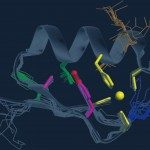Link to Pubmed [PMID] – 28111015
Mol. Cell 2017 Feb;65(3):527-538.e6
Mutations in mtDNA lead to muscular and neurological diseases and are linked to aging. The most frequent aberrancy is the “common deletion” that involves a 4,977-bp region flanked by 13-bp repeats. To investigate the basis of this deletion, we developed a single-molecule mtDNA combing method. The analysis of replicating mtDNA molecules provided in vivo evidence in support of the asymmetric mode of replication. Furthermore, we observed frequent fork stalling at the junction of the common deletion, suggesting that impaired replication triggers the formation of this toxic lesion. In parallel experiments, we employed mito-TALENs to induce breaks in distinct loci of the mitochondrial genome and found that breaks adjacent to the 5′ repeat trigger the common deletion. Interestingly, this process was mediated by the mitochondrial replisome independent of canonical DSB repair. Altogether, our data underscore a unique replication-dependent repair pathway that leads to the mitochondrial common deletion.

